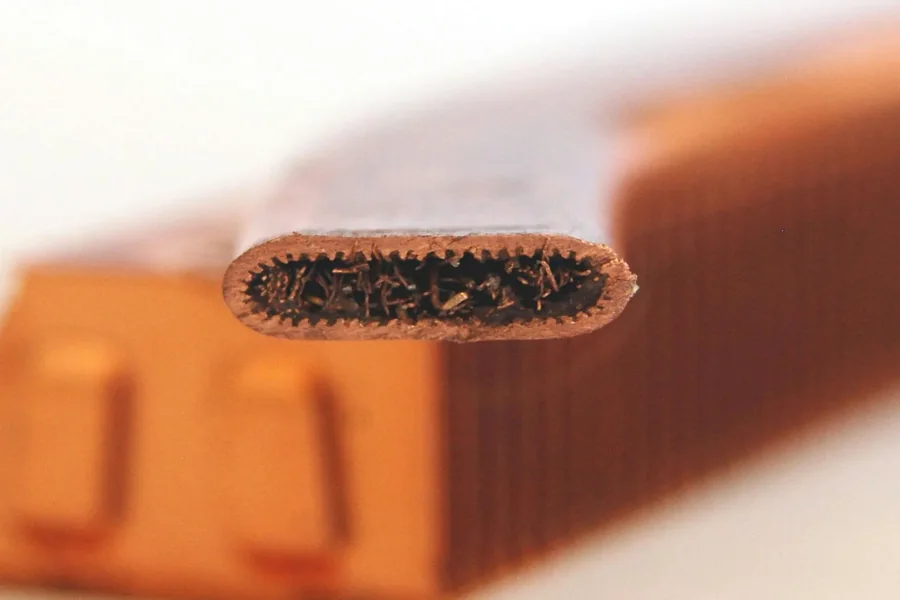As electronics get more powerful, keeping them cool is more important than ever. Two popular cooling methods are the vapor chamber vs heat pipe. People often debate which one is better. In this discussion, we’ll explain how each works, look at their pros and cons, and help you choose the right one for your needs.
What is a Heat Pipe?
A heat pipe is a very efficient device used to move heat from one solid surface to another. It works by using the process of liquid turning into vapor (evaporation) and then back into liquid (condensation) to transfer heat quickly and evenly.
How a Heat Pipe is Built and Works
A typical heat pipe has three main parts:
- Shell: A sealed container made of a metal like copper or aluminum that lets heat pass through easily.
- Wick Structure: It’s a material with tiny holes inside the walls that pulls the liquid back from the cooler end to the hotter end, working like a sponge that soaks up and moves water.
- Working Fluid: A special liquid inside (like water, ammonia, or ethanol) that evaporates when heated and condenses when cooled.
How It Works Step-by-Step:
- Evaporation: The liquid at the hot end absorbs heat and turns into vapor.
- Vapor Transport: The vapor moves along the pipe toward the cooler end.
- Condensation: The vapor cools down and turns back into liquid, releasing heat.
- Liquid Return: The liquid travels back to the hot end through the wick, and the cycle repeats.
Key Features of Heat Pipes
- Very Efficient: Heat pipes transfer heat up to 1,000 times faster than copper.
- Even Temperature: They maintain a consistent temperature throughout.
- No Moving Parts: This makes them very reliable and low-maintenance.
- Works Any Way: Heat pipes can work in any position, even upside down, depending on the wick inside.
Heat pipes efficiently move heat to keep devices cool and reliable.
What Are Vapor Chambers?
A vapor chamber is a thin, flat metal plate (usually copper or aluminum) sealed shut with a small amount of liquid inside. It cools devices by turning the liquid into vapor when heated, then spreading the heat evenly across its surface before the vapor cools back into liquid. This helps keep powerful, small electronics from overheating.
How It’s Built
- Flat Metal Plate: The chamber is a sealed metal plate with a hollow space inside.
- Wick Structure: Inside the plate, there’s a special wick (made of mesh, powder, or grooves) that moves liquid back to the hot area.
- Working Fluid: A small amount of liquid (often water) is sealed inside under vacuum to evaporate at lower temperatures.
How It Works
- Evaporation: Heat from a component (like a CPU or GPU) enters the bottom of the vapor chamber, causing the liquid to evaporate.
- Vapor Spreads: The vapor quickly spreads out inside the chamber toward cooler areas.
- Condensation: The vapor cools down and turns back into liquid, releasing heat to a heat sink or metal fins.
- Return Flow: The wick pulls the liquid back to the hot spot, starting the cycle again.
This cycle spreads the heat evenly across the surface, keeping the component cool.
Key Features of Vapor Chambers:
- Flat and Thin: It’s a thin, sealed metal plate (usually copper or aluminum) that fits nicely in small spaces.
- Spreads Heat Evenly: It spreads heat evenly to prevent any hot spots.
- Works with Evaporation and Condensation: It moves heat by turning the liquid inside into vapor, then back into liquid.
- Has a Wick Inside: A special sponge-like material inside helps pull the liquid back to the hot spot.
- Cool Powerful Electronics: Ideal for cooling powerful, compact parts like graphics cards and gaming laptops.
- Helps Devices Work Better: Maintains steady temperatures to help devices perform well and last longer.
A vapor chamber is a thin, flat device that spreads heat evenly using evaporation and condensation. It’s ideal for powerful, compact electronics that need reliable and efficient cooling.
Key Differences: Heat Pipes vs. Vapor Chambers
Heat pipes and vapor chambers use phase-change cooling (evaporation and condensation), but they’re built differently and are better suited for different tasks.
1. How They Move Heat
-
- Heat Pipes: Heat moves from hot to cool parts in one direction, making it good for moving heat over longer distances.
- Vapor Chambers: Spreads heat in two directions across flat surfaces, ideal for wide, hot areas like GPUs.
2. How Much Heat They Can Handle
-
- Heat Pipes: Excellent heat transfer (6,000–28,000 W/m·K), best for short to medium distances but less efficient if bent or too long.
- Vapor Chambers: Transfers heat very well (10,000–50,000 W/m·K), perfect for spreading lots of heat evenly across flat surfaces.
3. Design Flexibility
-
- Heat Pipes: Can bend easily to fit small spaces, perfect for designs like laptops and desktops.
- Vapor Chambers: It’s stiff and flat, so it works best in simple designs with big, flat heat areas.
4. Cost and Manufacturing
-
- Heat Pipes: Cheaper and easier to make, great for budget builds.
- Vapor Chambers: More complex to build and cost more, due to vacuum-sealed flat design and precision materials.
Pros and Cons
Heat Pipes
1. Pros:
-
- Well-Proven Tech: Used for decades in electronics, aerospace, and industry.
- Budget-Friendly: Simple tube design makes them cheaper and easier to produce than vapor chambers.
- Great for Point-to-Point Cooling: Ideal for moving heat between spots, even around bends.
2. Cons:
-
- Not Great for Spreading Heat: Since they move heat in one direction, you need multiple pipes to cover large chips—takes up more space and costs more.
- Position Matters: Performance can drop if not positioned properly (e.g., upside down), depending on the wick design.
Vapor Chambers
1. Pros:
-
- Spreads Heat Evenly: Flat design spreads heat evenly, preventing hot spots.
- Uniform Temperature: Keeps the whole surface at the same temperature without any hot or cold spots.
- Best for Small, Hot Devices: Ideal for powerful, compact electronics such as GPUs, gaming laptops, and smartphones.
2. Cons:
- More Expensive: Complex construction makes them pricier than heat pipes.
- Harder to Build and Fit: Their rigid, flat shape needs precision manufacturing and doesn’t work well in oddly shaped or tight spaces.
When to Use Each
- Use Heat Pipes if: Use heat pipes when you need to transfer heat over a distance, stay within budget, and design flexible cooling solutions that fit various shapes.
- Use Vapor Chambers if: Use vapor chambers when you need to spread heat evenly in small, powerful devices that require steady cooling.
Conclusion
Heat pipes and vapor chambers both cool by evaporation and condensation, but suit different needs. Heat pipes are affordable, flexible, and ideal for moving heat over distances in tight spaces or budgets. Vapor chambers spread heat evenly across flat surfaces, perfect for powerful, compact devices needing steady cooling. Choose heat pipes for cost and flexibility, or vapor chambers for uniform, high-performance cooling.





